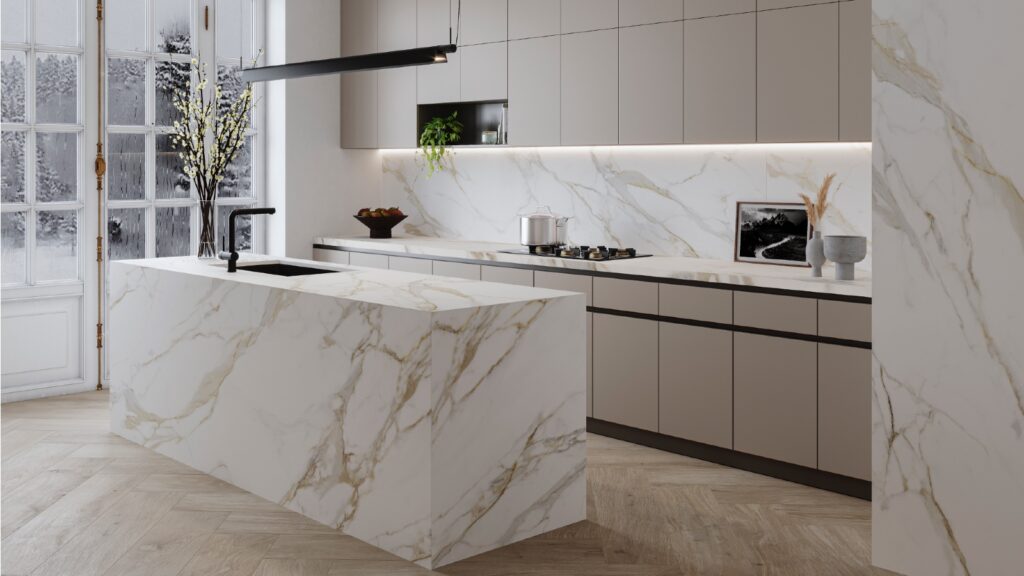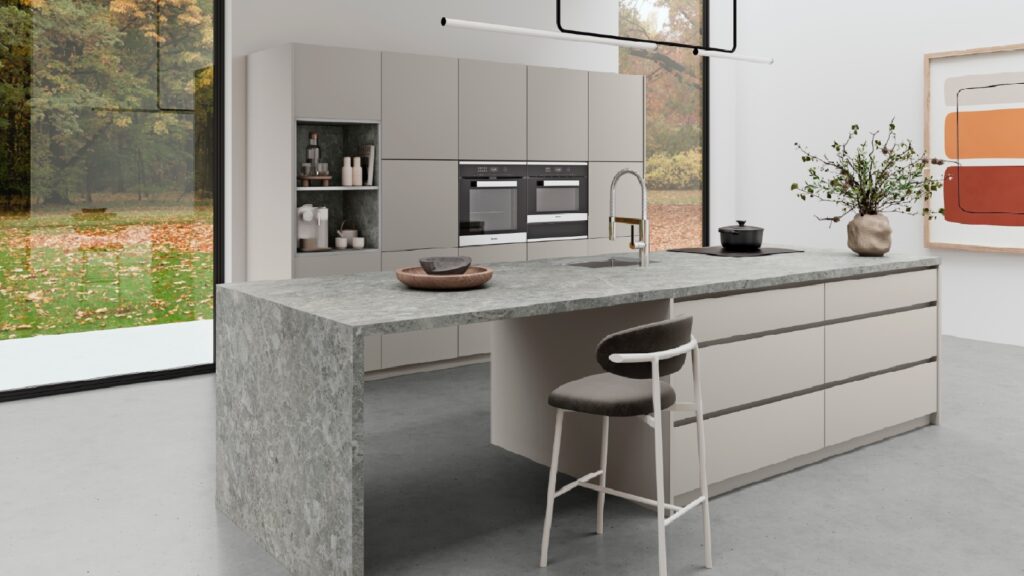Philippa Turrell looks at how Arts & Crafts is becoming an alternative to mainstream, contemporary kitchens
Apart from discussing the weather, queuing and Pimms, there’s nothing more quintessentially British than an Arts & Crafts – or for the sake of argument – classical kitchen. It’s a look that recently seemed to be all but erased from the media spotlight when the chic, sleek lines of the high gloss, handleless kitchen caught the attention of the masses. So you could be forgiven the style pendulum has swung back to these timeless designs, with the likes of Mereway introducing ‘country’ styles, and even German manufacturers, such as SieMatic, unveiling more classical styles. But industry experts argue there has always been a market for the classical kitchen, despite a lack of media attention. Commercial director of Masterclass Kitchens, Steve Tough comments: “The market for Arts & Crafts kitchens never really went away, although a lot of emphasis has been placed on minimalist, contemporary designs until recently. Consumers are increasingly seeking to create a timeless, homely feeling in the kitchen, which is why there has been something of resurgence in Arts & Crafts styles of late.” In fact, marketing director of the Symphony Group Simon Collyns believes: “Traditional designs never go out of style.”
Classical kitchen split
In fact such is the continued popularity of the Arts & Crafts-style kitchen, that experts believe the market remains split. And if we view sales as proportionally represented by brochures, it could be up to 33% as indicated by Masterclass Kitchens. Steve Tough of Masterclass Kitchens points out: “Around one third of our catalogue of kitchen cabinetry is Arts & Crafts or more classically styled, reflecting the demand for such kitchens among our customers.” And product manager of HPP, Mark Smith agrees, pointing out: “this area does seem to be increasing at a reasonable rate”, adding it’s difficult to apportion sales to Arts & Crafts as demand overlapped with styles such as Shaker “which are very similar in many ways to Arts & Crafts”.
Sponsored Video
Modern classic style
Of course the Arts & Crafts or modern classical designs are not the same of the original movement. It’s a crossover combining the warmth of a classical kitchen with a modern twist. That’s the belief of senior designer at PWS Graeme Smith who comments: “Whilst I don’t see the Arts & Crafts style in its pure form seeing resurgence, there are certainly elements of this era that are influencing classic-designed kitchens. Where there is a nod to this style is in the shapes that are featured in timeless designs. The other strong influence around the time of the Arts & Crafts movement, the prevalence of more organic forms and these are noticeably echoed in classic schemes.”
So what should kitchen designers, retailers or specifiers consider when creating a classic kitchen, which echoes the spirit of the Arts & Crafts movement? Steve Tough of Masterclass explains: “Arts & Crafts kitchens are defined largely by straight lines and heavy proportion, with little in the way of excessive ornamentation. The trick is to keep things simple and unfussy.”
To create a modern classic version of the Arts & Crafts kitchen, accomplished retailers and designers may take a simple Shaker door, for example, or a more modern derivative of a Shaker door, with perhaps a reduced keyline, a thin frame and these can be teamed with open-plan shelving, in country or even more modern styles. Graeme Smith of PWS advises: “Rather than opting for richer timbers and highly decorative door styles, lighter oaks with simple embellishment, such as a quarter round beading would be more appropriate in today’s market.”
Combining two decors
However, it’s not simply the form of kitchens inspired by the Arts & Crafts movement but also the decors, with painted furniture growing in stature along with timber. In fact, the combination of both of these finishes has seen the development of two-tone timber and painted kitchens. And, in fact, Mereway recently took the combination one step further by producing images for its Town & Country Collection featuring up to five finishes.
Graeme Smith explains paint offers a more modern version of the Arts & Crafts classical kitchen, continuing: “Painted doors will bring the look up to date whilst accessorising with features that are reminiscent of the Arts & Crafts style. In terms of colour palette, those tones influenced by William Morris as well as muted natural colours, for instance stone teamed with porcelain to add a contemporary air to a scheme.” And Steve Tough agrees: “A soft, gentle colour palette often works well in combination with natural timbers, with the latest on trend colours of grey and powder blue being chosen to prevent the kitchen from looking too old-fashioned.”
These combined decors not only bring in the warmth and texture that consumers crave but have become a key look for mid to top-end retailers and designers. The combination not only allows experienced kitchen designers to explore their own abilities in creating individual schemes for consumers but differentiates their offer from local competition.
Best by Brits?
Of course, there will be few British manufacturers who argue they are not in the best place to service the customer who wants an Arts & Crafts kitchen. “Only UK manufacturers can pull off this look in terms of quality and design certainly”, exclaims Tough. While Simon Collyns gives a little more detail: “We’re very good at the traditional design as it is engrained in our heritage, it fits in with our lifestyle and the way we use our homes. What makes the design is a combination of uniquely British features – from the door styles, colours with accessories like handles, cornice and the use of oak drawers and cabinet colours; these are all elements which the European designers struggle to replicate.”
However, with the aid of a history lesson Mark Smith of HPP contests British manufacturers hold the key to Arts & Crafts kitchens. He points out: “Whilst the arts and crafts look stemmed from Britain (making it a typical British look), the Arts & Crafts movement spread throughout the late 19th century across Europe and America quite rapidly; so whilst the look very much originate from Britain, it would probably be fair to say that German manufacturers could also offer a suitable range of products that could just as easily cater to these re-emerging consumer tastes and styles.”
Rural and urban
So is the market has just been too limited for European manufacturers, as it really only caters for a customer base living in selected UK rural or historic localities? “There is some mileage in the belief that a customer living in a rural, country-style property is more likely to go down an Arts & Crafts kitchen route. A contemporary kitchen would simply look out of place in such situations so this offers something of a middle ground”, explains Tough. But he points out: “That’s not to say that you wouldn’t find an Arts & Crafts kitchen in an urban, city dwelling though, it’s just down to individual taste and the character of the building itself.” And Simon Collyns is even more emphatic that choice, not locality, is key to sales: “You have to be careful when making generalisations about a typical customer for a certain region as everyone is influenced by the same programmes and magazines or even boars on Pinterest whether they live in the country or in Central London. There is never one right style or design for each region. It is no longer possible to pigeon-hole customers by the demographics of age, location or income.”
Strong sales and growing
Certainly kitchen furniture experts seem to agree that the Arts & Crafts-inspired kitchen will remain a strong alternative to the high or matt gloss handleless designs. Steve Tough says: “The market for Arts & Crafts kitchens will always be with us as it offers something of a middle ground between very modern and very traditional styles.” However, Mark Smith believes there is even further room for growth, adding “popularity for this style of kitchen is likely to still increase thanks to consumers’ shifts in tastes to something more traditional and historic” and he predicts: “Premium and custom-made kitchen are likely to see the biggest rise in this area of the market, as a true arts and crafts kitchen boasts high levels of craftsmanship such as dovetailed joints, mortice and tenon carpentry and quality that should last for much longer than a typical kitchen would be expected to.”
So, while high and matt gloss kitchens will undoubtedly remain a staple for high street kitchen sales – don’t forget Crafts work!
This feature first appeared in Kitchens & Bathrooms News July/August 2015 issue



